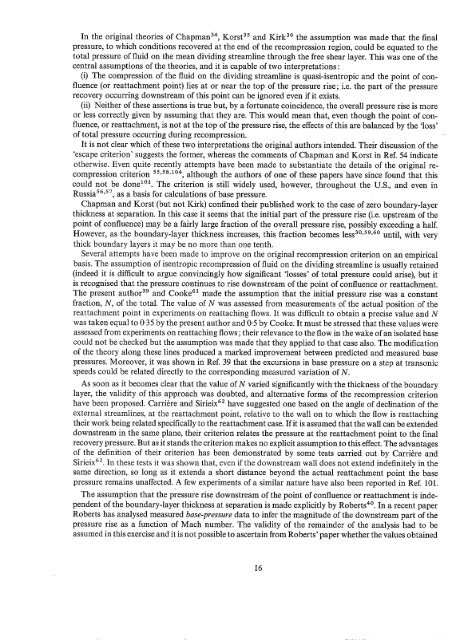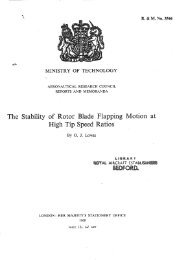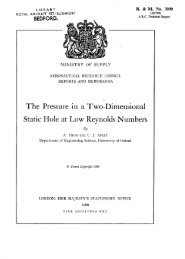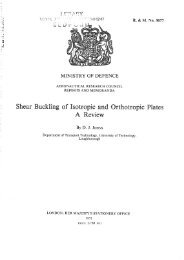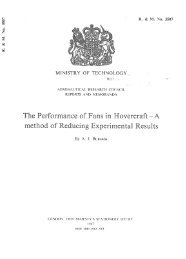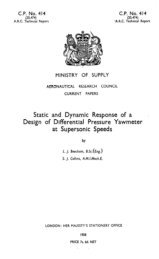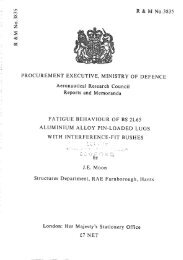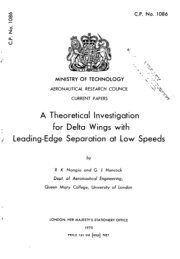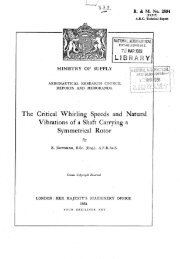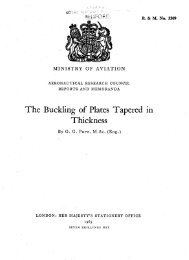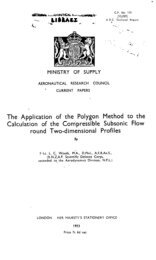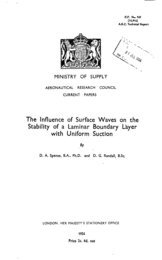A Discussion of Two-Dimensional Turbulent Base Flows - aerade
A Discussion of Two-Dimensional Turbulent Base Flows - aerade
A Discussion of Two-Dimensional Turbulent Base Flows - aerade
Create successful ePaper yourself
Turn your PDF publications into a flip-book with our unique Google optimized e-Paper software.
In the original theories <strong>of</strong> Chapman 34, Korst 35 and Kirk 36 the assumption was made that the final<br />
pressure, to which conditions recovered at the end <strong>of</strong> the recompression region, could be equated to the<br />
total pressure <strong>of</strong> fluid on the mean dividing streamline through the free shear layer. This was one <strong>of</strong> the<br />
central assumptions <strong>of</strong> the theories, and it is capable <strong>of</strong> two interpretations :<br />
(i) The compression <strong>of</strong> the fluid on the dividing streamline is quasi-isentropic and the point <strong>of</strong> con-<br />
fluence (or reattachment point) lies at or near the top <strong>of</strong> the pressure rise; i.e. the part <strong>of</strong> the pressure<br />
recovery occurring downstream <strong>of</strong> this point can be ignored even if it exists.<br />
(ii) Neither <strong>of</strong> these assertions is true but, by a fortunate coincidence, the overall pressure rise is more<br />
or less correctly given by assuming that they are. This would mean that, even though the point <strong>of</strong> con-<br />
fluence, or reattachment, is not at the top <strong>of</strong> the pressure rise, the effects <strong>of</strong> this are balanced by the 'loss'<br />
<strong>of</strong> total pressure occurring during recompression.<br />
It is not clear which <strong>of</strong> these two interpretations the original authors intended. Their discussion <strong>of</strong> the<br />
'escape criterion' suggests the former, whereas the comments <strong>of</strong> Chapman and Korst in Ref. 54 indicate<br />
otherwise. Even quite recently attempts have been made to substantiate the details <strong>of</strong> the original re-<br />
compression criterion s5,58.1o4, although the authors <strong>of</strong> one <strong>of</strong> these papers have since found that this<br />
could not be done TM. The criterion is still widely used, however, throughout the U.S., and even in<br />
Russia 56'57, as a basis for calculations <strong>of</strong> base pressure.<br />
Chapman and Korst (but not Kirk) confined their published work to the case <strong>of</strong> zero boundary-layer<br />
thickness at separation. In this case it seems that the initial part <strong>of</strong> the pressure rise (i.e. upstream <strong>of</strong> the<br />
point <strong>of</strong> confluence) may be a fairly large fraction <strong>of</strong> the overall pressure rise, possibly exceeding a half.<br />
However, as the boundary-layer thickness increases, this fraction becomes less 3°'59'6° until, with very<br />
thick boundary layers it may be no more than one tenth.<br />
Several attempts have been made to improve on the original recompression criterion on an empirical<br />
basis. The assumption <strong>of</strong> isentropic recompression <strong>of</strong> fluid on the dividing streamline is usually retained<br />
(indeed it is difficult to argue convincingly how significant 'losses' <strong>of</strong> total pressure could arise), but it<br />
is recognised that the pressure continues to rise downstream <strong>of</strong> the point <strong>of</strong> confluence or reattachment.<br />
The present author 39 and Cooke 61 made the assumption that the initial pressure rise was a constant<br />
fraction, N, <strong>of</strong> the total. The value <strong>of</strong> N was assessed from measurements <strong>of</strong> the actual position <strong>of</strong> the<br />
reattachment point in experiments on reattaching flows. It was difficult to obtain a precise value and N<br />
was taken equal to 0.35 by the present author and 0.5 by Cooke. It must be stressed that these values were<br />
assessed from experiments on reattaching flows; their relevance to the flow in the wake <strong>of</strong> an isolated base<br />
could not be checked but the assumption was made that they applied to that case also. The modification<br />
<strong>of</strong> the theory along these lines produced a marked improvement between predicted and measured base<br />
pressures. Moreover, it was shown in Ref. 39 that the excursions in base pressure on a step at transonic<br />
speeds could be related directly to the corresponding measured variation <strong>of</strong> N.<br />
As soon as it becomes clear that the value <strong>of</strong> N varied significantly withthe thickness <strong>of</strong> the boundary<br />
layer, the validity <strong>of</strong> this approach was doubted, and alternative forms <strong>of</strong> the recompression criterion<br />
have been proposed. Carri6re and Sirieix 62 have suggested one based on the angle <strong>of</strong> declination <strong>of</strong> the<br />
external streamlines, at the reattachment point, relative to the wall on to which the flow is reattaching<br />
their work being related specifically to the reattachment case. If it is assumed that the wall can be extended<br />
downstream in the same plane, their criterion relates the pressure at the reattachment point to the final<br />
recovery pressure. But as it stands the criterion makes no explicit assumption.to this effect. The advantages<br />
<strong>of</strong> the definition <strong>of</strong> their criterion has been demonstrated by some tests carried out by Carri6re and<br />
Sirieix 62. In these tests it was shown that, even if the downstream wall does not extend indefinitely in the<br />
same direction, so long as it extends a short distance beyond the actual reattachment point the base<br />
pressure remains unaffected. A few experiments <strong>of</strong> a similar nature have also been reported in Ref. 101.<br />
The assumption that the pressure rise downstream <strong>of</strong> the point <strong>of</strong> confluence or reattachment is inde-<br />
pendent <strong>of</strong> the boundary-layer thickness at separation is made explicitly by Roberts 4°. In a recent paper<br />
Roberts has analysed measured base-pressure data to infer the magnitude <strong>of</strong> the downstream part <strong>of</strong> the<br />
pressure rise as a function <strong>of</strong> Mach number. The validity <strong>of</strong> the remainder <strong>of</strong> the analysis had to be<br />
assumed in this exercise and it is not possible to ascertain from Roberts' paper whether the values obtained<br />
16


